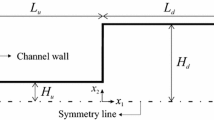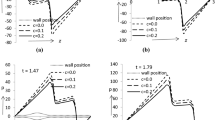Abstract
This paper proposes a framework for modelling velocity profiles and suspended objects in non-Newtonian fluid environment. A setup is proposed to allow mimicking blood properties and arterial to venous dynamic flow changes. Navier-Stokes relations are employed followed by fractional constitutive equations for velocity profiles and flow. The theoretical analysis is performed under assumptions of steady and pulsatile flow conditions, with incompressible properties. The fractional derivative model for velocity and friction drag effect upon a suspended object are determined. Experimental data from such an object is then recorded in real-time and identification of a fractional order model performed. The model is determined from step input changes during pulsatile flow for velocity in the direction of the flow. Further on, this model can be employed for controller design purposes for velocity and position in pulsatile non-Newtonian fluid flow.
Similar content being viewed by others
References
G. Ala, M. Di Paola, E. Francomano, Y. Li, F. Pinnola, Electrical analogous in viscoelasticity. Commun. Nonlinear Sci. Numer. Simul. 19 (2014), 2513–2527. 10.1016/j.cnsns.2013.11.007.
A. Berglund, J.A. Liddle, Simultaneous positioning and orientation of a single nano-object by flow control: theory and simulations. New J. of Phys. 13 (2011). 10.1063/1.2148627.
D. Yin, H. Wu, C. Cheng, Y. Q. Chen, Fractional order constitutive model of geomaterials under thecondition of triaxial test. Intern. J. for Numer. and Anal. Methods in Geomechanics 37, No8 (2013), 961–972. 10.1002/nag.2139.
I. Birs, C. Muresan, S. Folea, O. Prodan, An experimental nanomedical platform for controller validation on targeted drug delivery, Proc. of the Australian and New Zealand Control Conf., ANZCC. (2017), Gold Coast, Australia. 10.1109/ANZCC.2017.8298504.
I. Birs, C. Muresan, O. Prodan, S. Folea, C.M. Ionescu, Analytical modeling and preliminary fractional order velocity control of a small scale submersible, 2018 SICE Intern. Symp. on Control Systems, SICEISCS Japan (2018), 157–162. 10.23919/SICEISCS.2018.8330170.
D. Copot, R. Magin, R. De Keyser, C.M. Ionescu, Data-driven modelling of drug tissue trapping using anomalous kinetics. Chaos Solitons and Fractals 102 (2017), 441–446. 10.1016/j.chaos.2017.03.031.
D. Craiem, R. Armentano, A fractional derivative model to describe arterial viscoelasticity. Biorheology 44, No4 (2007), 251–263. 10.1109/IEMBS.2006.259709.
D. Craiem, F. Rojo, J. Atienza, R. Armentano, G. Guinea, Fractionalorder viscoelasticity applied to describe uniaxial stress relaxation of human arteries. Phys. Med. Biol. 53, No17 (2008), 4543–4554. 10.1088/0031-9155/53/17/006.
K. Dekemele, C.M. Ionescu, M. De Doncker, R. De Keyser, Closed loop control of an electromagnetic stirrer in the continuous casting process, Proc. of the European Control Conf.. (2016), Aalborg, Denmark 61–66. 10.1109/ECC.2016.7810264.
A. Dokoumetzidis, R. Magin, P. Macheras, Fractional kinetics in multicompartmental systems. J. Pharmacokinet Pharmacodyn 37 (2010), 507–524. 10.1007/s10928-010-9170-4.
C.M. Ionescu, A memory-based model for blood viscozity. Commun. on Nonlin. Sci. and Numer. Simul. 45 (2017), 29–34. 10.1016/j.cnsns.2016.09.017.
C.M. Ionescu, J.F. Kelly, Fractional calculus for respiratory mechanics: power law impedance, viscoelasticity and tissue heterogeneity. Chaos, Solitons and Fractals 102 (2017), 433–440. 10.1016/j.chaos.2017.03.054.
C.M. Ionescu, A. Lopes, D. Copot, J.A.T. Machado, J.H.T. Bates, The role of fractional calculus in modelling biological phenomena: a review. Commun. in Nonlin. Sci. and Numer. Simul. 51 (2017), 141–159. 10.1016/j.cnsns.2017.04.001.
C.M. Ionescu, J.A.T. Machado, R. De Keyser, Modeling of the lung impedance using a fractional order ladder network with constant phase elements. IEEE Trans. Biomed. Eng. 5, No1 (2011), 83–89. 10.1109/TBCAS.2010.2077636.
J.F. Kelly, R.J. McGough, Fractal ladder models and power law wave equations. J. of the Acoustical Soc. of America 126, No4 (2009), 2072–2081. 10.1121/1.4783441.
C.D. Langevin, Modeling axisymmetric flow and transport. Ground Water 46, No4 (2008), 579–590.
L.G. Leal, The motion of small particles in non-Newtonian fluids. J. of Non-Newtonian Fluid Mechanics 5 (1979), 33–78. 10.1016/0377-0257(79)85004-1.
Y. Li, Y.Q. Chen, I. Podlubny, Mittag—Leffler stability of fractional order nonlinear dynamic systems. Automatica 45, No8 (2009), 1965–1969. 10.1016/j.camwa.2009.08.019.
Y. Li, Y.Q. Chen, I. Podlubny, Stability of fractional-order nonlinear dynamic systems: Lyapunov direct method and generalized Mittag-–Leffler stability. Computers and Math. with Appl. 59, No5 (2010), 1810–1821. 10.1016/j.camwa.2009.08.019.
R. Magin, Fractional calculus in bioengineering. Crit. Rev. Biomed. Eng. 32, No1 (2004), 1–104. 10.1615/CritRevBiomedEng.v32.10.
MAN Diesel & Turbo, Basic Principles of Ship Propulsion. (2012).
R. Pintelon, J. Schoukens, System Identification: A Frequency Domain Approach.. Wiley-IEEE Press (2001). 10.1002/9781118287422.
I. Podlubny, Geometric and physical interpretation of fractional integration and fractional differentiation. Fract. Calc. Appl. Anal. 5, No4 (2002), 367–386. see at: arXiv:math/0110241.
Y. Saadeh, D. Vyas, Nanorobotic applications in medicine: current proposals and designs. Amer. J. Robot. Surg. 1, No1 (2014), 4–11. 10.1166/ajrs.2014.1010.
H. Schiessel, A. Blumen, Mesoscopic pictures of the sol-gel transition: ladder models and fractal networks. Mectromolecules 28 (1995), 4013–4019. 10.1021/ma00115a038.
J. Venugopal, M.P. Prabhakaran, S. Low, A.T. Choon, Y.Z. Zhang, G. Deepika, S. Ramakrishna, Nanotechnology for nanomedicine and delivery of drugs. Curr. Pharm. Des. 14, No8 (2008), 2184–2200. 10.2174/138161208785740180.
B. West, Fractal physiology and the fractional calculus: a perspective. Frontiers in Physiology. (2010). 10.3389/fphys.2010.00012.
C. Ionescu, A. Lopes, D. Copot, J.A.T. Machado, J.H.T. Bates, The role of fractional calculus in modeling biological phenomena: A review. Commun. in Nonl. Sci. and Numer. Simul. 51 (2017), 141–159. 10.1016/j.cnsns.2017.04.001.
D. Yin, W. Zhang, C. Cheng, L. Yi, Fractional time-dependent Bingham model for muddy clay. J. Non-Newtonian Fluid Mech. 187 (2012), 32–35. 10.1016/j.jnnfm.2012.09.003.
Author information
Authors and Affiliations
Corresponding author
About this article
Cite this article
Birs, I., Muresan, C., Copot, D. et al. Identification for Control of Suspended Objects in Non-Newtonian Fluids. FCAA 22, 1378–1394 (2019). https://doi.org/10.1515/fca-2019-0072
Received:
Revised:
Published:
Issue Date:
DOI: https://doi.org/10.1515/fca-2019-0072




